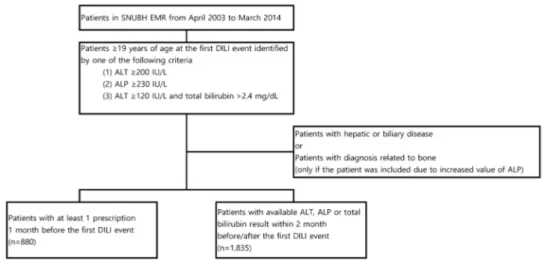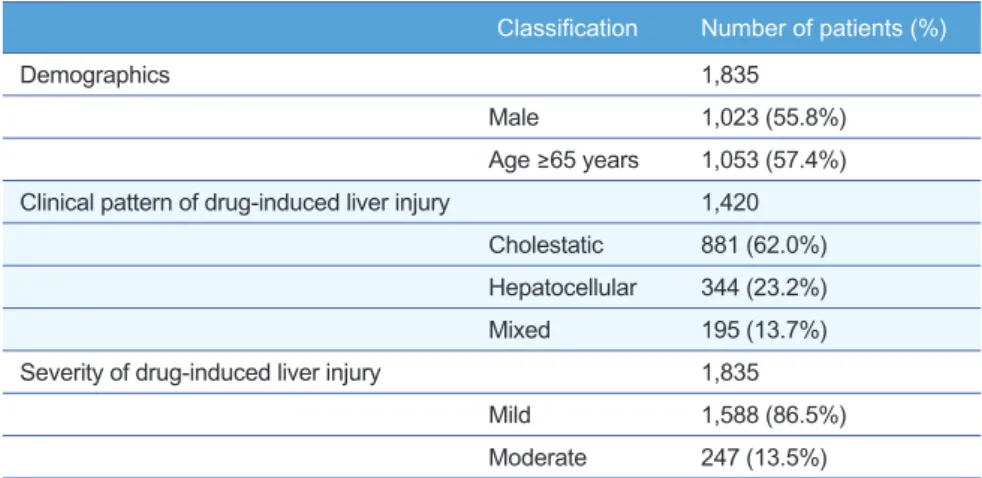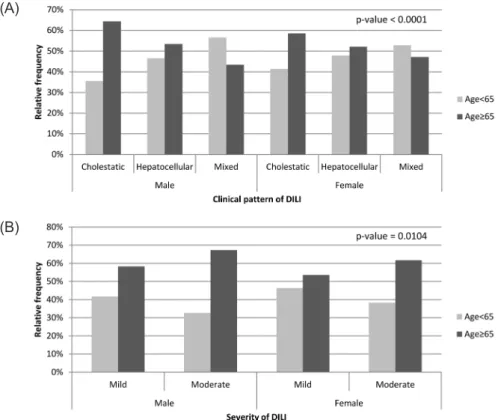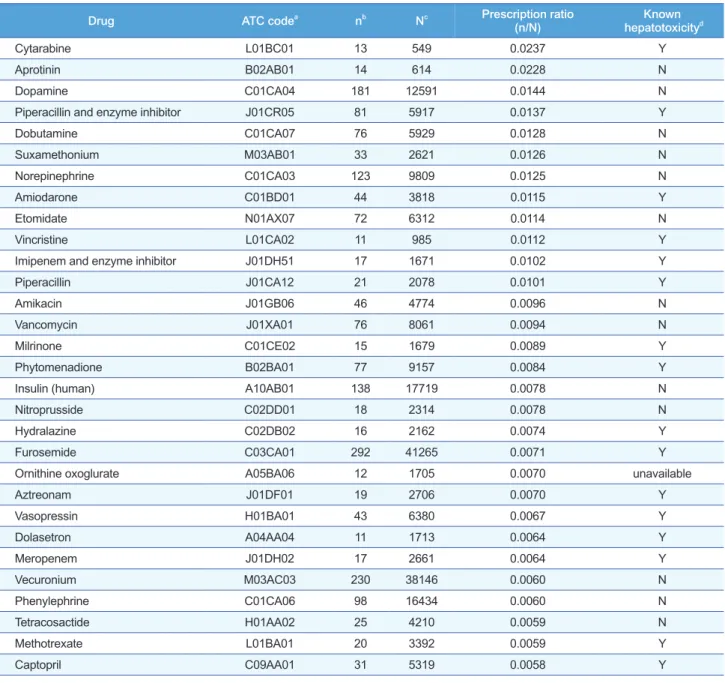TCP
Transl Clin Pharmacol http://dx.doi.org/10.12793/tcp.2016.24.2.78 2016;24(2):78-83Evaluation of factors associated with
drug-induced liver injury using electronic medical records
Hyewon Chung
1+, Hyungmi An
1+, Jieon Lee
1, Jaeseong Oh
1, Kyung-Sang Yu
1and Jae-Yong Chung
2*
1Department of Clinical Pharmacology and Therapeutics, Seoul National University College of Medicine and Hospital, Seoul 03080, Korea, 2Department of Clinical Pharmacology and Therapeutics, Seoul National University College of Medicine and Bundang Hospi- tal, Seongnam 13620, Korea
*Correspondence: J. Y. Chung; Tel: +82-31-787-3955, Fax: +82-31-787-4045, E-mail: jychung@snubh.org
+These authors have contributed equally to the work.
The causes and attributing factors of drug-induced liver injury (DILI) remain unclear as a result of exclusion-based diagnosis and low incidence. The aim of this study was to explore and evaluate potential drug-related causes and factors associated with DILI. Using electronic medical records (EMR) from the Seoul National University Bundang Hospital from 2003 to 2014, patients with DILI events were identified based on liver function test results. All patients with hepatic or biliary diseases were excluded. Patient characteristics, including demographics, clinical patterns, and se- verity of DILI were summarized and their associations were evaluated. Drugs frequently prescribed to patients exhibiting DILI within the month before their first DILI event compared to the total patient population were identified and the probabilities of hepatotoxicity associated with their use were assessed through examination of available reports. Among the 1,835 patients with laboratory test results, 1,023 were male and 1,053 were 65 years of age or older. Moderate DILI was dominant in older or male patients and cholestatic DILI tended to be more frequently identified in older pa- tients of either sex. Cytarabine was the most frequently prescribed drug in DILI patients, followed by aprotinin and dopamine. Among the 30 most frequently prescribed drugs in DILI patients, 15 (50%) were identified as known hepatotoxic agents. In conclusion, this study evaluated differences in features of DILI among groups based on demographics and explored candidate drugs with pos- sible associations with DILI, which has potential value reflecting real-world clinical practice.
Introduction
Drug-induced liver injury (DILI) is a major concern that can lead to liver failure or even death. Because DILI is typically diag- nosed based on exclusion of other possible causes and many pa- tients have more than one drug administered before the event, the culprit drug and attributing factors for DILI remain unclear.
Indeed, one study reported that the diagnosis was incorrect or could not be proven in 25% of DILI diagnoses.[1] Furthermore, the crude annual incidence rate of DILI is low at 13.9 cases per 100,000 inhabitants in France and 19.1 cases per 100,000 in
Iceland, which may also contribute to the limited knowledge of DILI.[2,3]
There have been several attempts to determine causative drugs or characteristics of DILI. In 2011, an international DILI Expert Working Group of clinicians and scientists developed standard DILI case definitions and phenotypes in order to facilitate cross- study comparisons and collaborations.[4] Shin et al. used these standardized criteria to evaluate a large patient population based on electronic medical records (EMR).[5] By focusing on 14 medications commonly associated with hepatotoxicity, they reported results similar to those of previous prospective studies and suggested the value of large electronic healthcare databases for assessment of liver injury causality.
In this study, in contrast to a previous study,[5] we did not previously specify any drugs to be analyzed as candidate drugs
Copyright © 2016 Translational and Clinical Pharmacology
It is identical to the Creative Commons Attribution Non-Commercial License (http://creativecommons.org/licenses/by-nc/3.0/).
This paper meets the requirement of KS X ISO 9706, ISO 9706-1994 and ANSI/NISO Z.39.48-1992 (Permanence of Paper).
Received 13 Dec 2015 Revised 25 Apr 2016 Accepted 30 Apr 2016
Keywords
Drug-induced liver injury, Electronic medical record, Hepatotoxicity
pISSN: 2289-0882 eISSN: 2383-5427
ORIGINAL ARTICLE
TCP
Transl Clin Pharmacol
for DILI causality. Thus, the aim of the current study was to use EMRs to explore candidate drugs that could be associated with development of DILI and to evaluate the characteristics of DILI and their associations with demographic factors.
Methods
Identification of drug-induced liver injury
DILI was defined as (i) elevated serum alanine aminotransfer- ase (ALT) concentration to ≥5 times the upper limit of normal range (ULN), (ii) elevated serum alkaline phosphatase (ALP) concentration to ≥2 times the ULN, or (iii) elevated ALT con- centration to ≥3 times the ULN and simultaneous elevation of total bilirubin concentration exceeding twice the ULN.[4,6] The ULNs for the laboratory tests at the Seoul National University Bundang Hospital (SNUBH) were 40 IU/L, 115 IU/L, and 1.2 mg/dL for ALT, ALP, and bilirubin, respectively.
The international DILI expert working group standards were also applied to identify not only DILI events, but also their characteristics (clinical patterns and severity).[4] Hepatocellular DILI was defined as liver chemistry thresholds of R≥5, where R is calculated as (ALT/ALT ULN)/(ALP/ALP ULN). Cholestatic and mixed DILI were defined as R≤2 and 2 <R< 5, respectively.
DILI severity was classified as mild for patients who met the DILI criteria with total bilirubin concentrations < 2 times the ULN and moderate for those with total bilirubin concentrations
≥ 2 times the ULN.
Subjects
The study was approved by the institutional review board of the SNUBH (Approval number: B-1506/302-118) and the data for eligible patients were exported from the EMR database of the SNUBH, Korea. The inclusion criteria were as follows: (i) at least 1 DILI event from April 2003 to March 2014 and (ii) ≥19
years of age at the first DILI event. To minimize the capture of non-drug-related liver injury data, the following exclusion criteria were applied: (i) patient who had a word ‘liver’, ‘hepato’,
‘hepatic’, ‘biliary’, ‘gallbladder’, ‘cholangi’, or ‘bile duct’ in their diagnosis at least once; (ii) patients diagnosed with disorders of bone density and structure, other osteopathy, or fracture if they were identified as having DILI due to increased ALP values.
The analysis of drugs related to development of DILI included patients with at least one prescription one month before the first DILI event, while the evaluation of the characteristics of DILI considered patients with available ALT, ALP, or total bilirubin results two months before and after the first DILI event (Fig. 1).
Data extraction process
To explore EMR data structure in SNUBH, we randomly ex- tracted 100 subjects who met the inclusion/exclusion criteria.
The data contained laboratory and prescription data with pa- tients’ demographic characteristics such as age, sex, and diag- nosis at the first DILI event. Based on these data, the statistical analysis plan and the data format to collect were determined.
Laboratory data contained test date, name of the test, value and units for ALT, ALP and total bilirubin 2 months before/after the first DILI event, and prescription data included brand name, ge- neric name, the hospital drug code, the anatomical therapeutic chemical (ATC) code of drugs prescribed 1 month before/after the first DILI event as well as age, sex, and diagnosis of patients at the first DILI event. Among the prescription data, drugs with ATC code of A11 (vitamins), A12 (mineral supplements), B05 (blood substitutes and perfusion solutions), and V (various) were excluded. Drugs not listed on the 5th level of ATC code classification system and drugs with topical use were also re- moved. The appropriate format and clinical range of each vari- able in the data set was examined by SAS 9.3 (SAS Institute Inc., Cary, NC, USA). To protect private information, the hospital’s
Figure 1. Inclusion and exclusion criteria and number of study patients. (SNUBH, Seoul National University Bundang Hospital; EMR, electronic medical records; DILI, drug-induced liver injury; ALT, alanine aminotransferase; ALP, alkaline phosphatase)
Hyewon Chung, et al.
TCP
Transl Clin Pharmacolpatient ID, which was the only data that could identify a patient, was substituted by a study specific ID at the time of data extrac- tion.
Data analysis
Patient demographic factors (age and sex) and DILI charac- teristics (clinical patterns and severity) were summarized by descriptive statistics. Cochran-Mantel-Haenszel tests were used to evaluate the associations between patient demographics and DILI characteristics. All statistical analyses were performed us- ing SAS 9.3.
To explore candidate drugs that may be associated with DILI, the frequency of drugs that had been prescribed to study pa- tients with DILI within the month before their first DILI event were compared to those prescribed to the total patient popula- tion using the prescription ratio. The prescription ratios (n/
N) were calculated as follows: the number of patients who had
been prescribed with a certain drug in the DILI population (n) over the number of patients who had been prescribed with the certain drug in the total population in EMR (N) during the same study period as the DILI population (April 2003 to March 2014). To prevent false positive results due to accidental detec- tion, drugs prescribed to subjects resulting in only a few DILI (n < 10) were excluded from the analysis. For drugs with a high prescription ratio, the probability of hepatotoxicity associated with their use were assessed using the Micromedex® database.[7]
Results
Among the 1,835 patients with available ALT, ALP, or total bilirubin results two months before and after the first DILI event, 1,023 (55.8%) were male and 1,053 (57.4%) were aged 65 years or more (Table 1). The average age for study patients was 66.0 with standard deviation (SD) of 16.5 and DILI events lasted 9.3 days on average with SD of 14.1. The relationship between patient demographics (age group and sex) and DILI characteristics (clini- cal patterns and severity) are shown in Table 2. The clinical pattern of DILI was defined for 1,420 patients and there was a significant associa- tion between age group and clinical pattern of DILI stratified by sex (P
< 0.0001). Cholestatic DILI tended to be more frequently identified in older patients (age ≥ 65 years) than in younger patients. The severity of DILI was also significantly associated with age group and sex. Moderate DILI was dominant in older patients after adjusting for sex (P = 0.0104), as well as in male patients after adjusting for age group (P = 0.0479) (Fig. 2).
Among the 880 patients with at least one prescription within the month before their first DILI event, cytarabine was the most frequently prescribed in DILI patients com- pared to all patients, with the highest prescription ratio (0.0237), followed by aprotinin and dopamine (0.0228 and 0.0144, respectively) (Table 3).
Among the 30 drugs with highest prescription ratio listed in Table 3, 15 drugs were identified as causing pos- sible hepatotoxicity in the Microme- dex® database.
Discussion
This study used EMR to evaluate factors associated with liver injury Classification Number of patients (%)
Demographics 1,835
Male 1,023 (55.8%)
Age ≥65 years 1,053 (57.4%) Clinical pattern of drug-induced liver injury 1,420
Cholestatic 881 (62.0%) Hepatocellular 344 (23.2%)
Mixed 195 (13.7%)
Severity of drug-induced liver injury 1,835
Mild 1,588 (86.5%)
Moderate 247 (13.5%) Table 1. Study patient characteristics
* Significant association between age group and clinical pattern of drug-induced liver injury (DILI) after adjusting for sex (P < 0.0001, Cochran-Mantel-Haenszel test). ** Significant association between age group and DILI severity after adjusting for sex (P = 0.0104, Cochran-Mantel-Haenszel test).
Table 2. The frequency of clinical patterns and severity of drug-induced liver injury by age group stratified by sex
Male Female
Age < 65
years Age ≥ 65
years Age < 65
years Age ≥ 65 years Clinical pattern of DILI*
Cholestatic 169 (35.6%) 306 (64.4%) 168 (41.4%) 238 (58.6%) Hepatocellular 94 (46.5%) 108 (53.5%) 68 (47.9%) 74 (52.1%)
Mixed 60 (56.6%) 46 (43.4%) 47 (52.8%) 42 (47.2%)
DILI severity**
Mild 363 (41.7%) 507 (58.3%) 333 (46.4%) 385 (53.6%) Moderate 50 (32.7%) 103 (67.3%) 36 (38.3%) 58 (61.7%) Drug-induced liver injury and electronic medical records
TCP
Transl Clin Pharmacol
Hyewon Chung, et al.
in patients visiting the SNUBH, focusing on demographic and liver chemistry characteristics and drugs prescribed before the liver injury event. Given DILI diagnosis is complex, the crite- ria for detecting case of DILI is the critical point for successful investigation. This study used standardized criteria, which will facilitate further integration of data from future investigations using the same criteria. Furthermore, this study offers a view of real-world clinical practice. The EMR data used in the study were accumulated over a 10-year period and were analyzed without any prior targeted diseases, drugs, or specific hypoth- eses.
Some of the results in this study are concordant with previ- ous reports. For example, it is known that a cholestatic pattern is more frequent in an older population compared to younger adults, although the underlying mechanism for this difference remains unknown.[8,9] The severity of the DILI differed signifi- cantly according to both age group and sex in the current study.
However, patients could not be classified as having severe DILI because clinical information, such as encephalopathy or ascites, necessary for classification was missing due to the unstructured nature of the data. Hence, only patients with mild or moder- ate DILI were identified in this study, and this limitation might have influenced the results.
Comparing the DILI patients to the total patients in EMR, cytarabine was the most frequently prescribed drug within 1
month before the DILI event. Although the exact mechanism of the hepatotoxicity is unclear, it has been reported to occur in up to 75% of leukemic patients after high dose cytarabine therapy.
[10] Including cytarabine, 50% of the 30 drugs listed in Table 3 were associated with hepatotoxicity. In other words, this study identified 15 new drugs that may be associated with DILI. Al- though causative analysis was not performed, the prescription ratio enabled to compare the relative association of DILI with the candidate drugs. For example, isoniazid, a drug well known for its hepatotoxicity, had a prescription ratio of 0.0051, and all 30 drugs listed on Table 3 had a higher prescription ratio than isoniazid. The finding of new drugs in our study might have arisen from differences in factors associated with susceptibil- ity to DILI among ethnicities. Suzuki et al. suggested regional divergences by reporting a unified list of drugs associated with liver injury using data sources from Spain, Sweden, and the United States.[11] They identified 369 drugs as causes of liver injury; among these, only 31 (9.7%) were identified in all three registries. Furthermore, a known ABCB11 p.444A polymor- phism related to drug-induced cholestasis in European studies was not significantly associated in Japanese study findings.[12]
Based on the indications of the drugs listed on Table 3, other factors such as surgical procedures (e.g., aprotinin, suxametho- nium, etomidate, and vecuronium) or hemodynamic instability (e.g., dopamine, dobutamine, norepinephrine, nitroprusside,
Figure 2. Frequencies of drug-induced liver injury (DILI) clinical pattern and severity by age group and sex (a, clinical pattern; b, severity; p-value from Cochran-Mantel-Haenszel test).
(A)
(B)
TCP
Transl Clin Pharmacolvasopressin, and phenylephrine) might have been causative of liver injury rather than the drug itself. In addition, ornithine oxoglurate, which is a drug administered in hepatitis or liver cirrhosis patients, is also listed on Table 3, and this suggests that patients with preexisting hepatic dysfunction may not be excluded completely from the DILI population. After exclud- ing drugs that are considered relatively unrelated to DILI, the remaining 19 agents were possible drugs associated with DILI
and most exhibited the hepatotoxicity reported in the Micro- medex® database. For four of these 19 drugs (amikacin, vanco- mycin, insulin, and tetracosactide), there was no information about hepatotoxicity in the database, although there are several reports suggesting the possibility of liver injury of vancomycin.
A wide range of hepatotoxicity, ranging from abnormalities in liver function tests to liver failure after vancomycin administra- tion, has been reported in association with drug reaction with
Drug ATC codea nb Nc Prescription ratio
(n/N) Known
hepatotoxicityd
Cytarabine L01BC01 13 549 0.0237 Y
Aprotinin B02AB01 14 614 0.0228 N
Dopamine C01CA04 181 12591 0.0144 N
Piperacillin and enzyme inhibitor J01CR05 81 5917 0.0137 Y
Dobutamine C01CA07 76 5929 0.0128 N
Suxamethonium M03AB01 33 2621 0.0126 N
Norepinephrine C01CA03 123 9809 0.0125 N
Amiodarone C01BD01 44 3818 0.0115 Y
Etomidate N01AX07 72 6312 0.0114 N
Vincristine L01CA02 11 985 0.0112 Y
Imipenem and enzyme inhibitor J01DH51 17 1671 0.0102 Y
Piperacillin J01CA12 21 2078 0.0101 Y
Amikacin J01GB06 46 4774 0.0096 N
Vancomycin J01XA01 76 8061 0.0094 N
Milrinone C01CE02 15 1679 0.0089 Y
Phytomenadione B02BA01 77 9157 0.0084 Y
Insulin (human) A10AB01 138 17719 0.0078 N
Nitroprusside C02DD01 18 2314 0.0078 N
Hydralazine C02DB02 16 2162 0.0074 Y
Furosemide C03CA01 292 41265 0.0071 Y
Ornithine oxoglurate A05BA06 12 1705 0.0070 unavailable
Aztreonam J01DF01 19 2706 0.0070 Y
Vasopressin H01BA01 43 6380 0.0067 Y
Dolasetron A04AA04 11 1713 0.0064 Y
Meropenem J01DH02 17 2661 0.0064 Y
Vecuronium M03AC03 230 38146 0.0060 N
Phenylephrine C01CA06 98 16434 0.0060 N
Tetracosactide H01AA02 25 4210 0.0059 N
Methotrexate L01BA01 20 3392 0.0059 Y
Captopril C09AA01 31 5319 0.0058 Y
Table 3. Top-30 drugs frequently prescribed to patients with drug-induced liver injury compared to the total population obtained from the electronic medical record database
a, Anatomical therapeutic chemical code; b, Number of patients who had been prescribed with the candidate drug in the drug-induced liver injury (DILI) population; c, Number of patients who had been prescribed with the certain drug in the total population in electronic medical record; d, Data based on Micromedex®.
Drug-induced liver injury and electronic medical records
TCP
Transl Clin Pharmacol
Hyewon Chung, et al.
eosinophilia and systemic symptoms (DRESS) syndrome.[13,14]
On the other hand, amikacin has been classified as an unlikely cause of clinically apparent liver injury.[15] To date, there is no information available elucidating the hepatotoxic mechanism of insulin and tetracosactide to the best of our knowledge.
In addition to the incomplete exclusion of drugs that were not associated with DILI, all drugs prescribed by primary physi- cians, over the counter drugs, and herbs were not present in the data from the SNUBH, since the SNUBH is a referral hospital.
Considering that herbal medications have been reported to be a principal cause of DILI and prescribed medication accounts for only 20.8% of cases in Korea, these agents might have acted as a confounding factor in this study.[16]
While large data extracted from databases such as EMRs offer many research advantages, especially for rare diseases or events, they also have inherent disadvantages. Furthermore, a retro- spective study has native limitations of uncontrolled conditions and the possibility of the existence of hidden factors. This study also presented difficulties in distinguishing the effects of specific drugs or demographic factors from extrinsic factors. Incorpo- rating data for invasive procedures, hospitalization periods, or duration of use of suspected drugs would be helpful for future studies. Non-structured data such as subjective symptoms, dietary supplements, or drug compliance should also be consid- ered.
In conclusion, this study evaluated differences in features of DILI among groups based on demographics and explored can- didate drugs having a possible association with DILI events. Al- though we were unable to clearly conclude the causative drugs of DILI, the approach in this study using relatively large clinical data might be helpful for future research.
Acknowledgements
This study was supported by a research grant from the SNUBH (Research number: 12-2013-026).
Conflict of interest
The authors declare that they have no conflict of interest.
References
1. Teschke R, Frenzel C, Wolff A, Eickhoff A, Schulze J. Drug induced liver
injury: accuracy of diagnosis in published reports. Ann Hepatol 2014;13:
248-255.
2. Sgro C, Clinard F, Ouazir K, Chanay H, Allard C, Guilleminet C, et al. Inci- dence of drug-induced hepatic injuries: a French population-based study.
Hepatology 2002;36:451-455. doi: 10.1053/jhep.2002.34857.
3. Björnsson ES, Bergmann OM, Björnsson HK, Kvaran RB, Olafsson S. In- cidence, presentation, and outcomes in patients with drug-induced liver injury in the general population of Iceland. Gastroenterology 2013;144:
1419-1425, 1425 e1411-1413. doi: 10.1053/j.gastro.2013.02.006.
4. Aithal GP, Watkins PB, Andrade RJ, Larrey D, Molokhia M, Takikawa H, et al. Case definition and phenotype standardization in drug-induced liver in- jury. Clin Pharmacol Ther 2011;89:806-815. doi: 10.1038/clpt.2011.58.
5. Shin J, Hunt CM, Suzuki A, Papay JI, Beach KJ, Cheetham TC. Character- izing phenotypes and outcomes of drug-associated liver injury using elec- tronic medical record data. Pharmacoepidemiol Drug Saf 2013;22:190- 198. doi: 10.1002/pds.3388.
6. Benichou C. Criteria of drug-induced liver disorders. Report of an interna- tional consensus meeting. J Hepatol 1990;11:272-276.
7. Micromedex® 2.0 (electronic version). http://www.micromedexsolutions.
com. Accessed Mar 20 2016.
8. Andrade RJ, Lucena MI, Fernandez MC, Pelaez G, Pachkoria K, Garcia- Ruiz E, et al. Drug-induced liver injury: an analysis of 461 incidences sub- mitted to the Spanish registry over a 10-year period. Gastroenterology 2005;129:512-521. doi: 10.1016/j.gastro.2005.05.006.
9. Lucena MI, Andrade RJ, Kaplowitz N, Garcia-Cortes M, Fernandez MC, Romero-Gomez M, et al. Phenotypic characterization of idiosyncratic drug- induced liver injury: the influence of age and sex. Hepatology 2009;49:2001- 2009. doi: 10.1002/hep.22895.
10. Herzig RH, Wolff SN, Lazarus HM, Phillips GL, Karanes C, Herzig GP.
High-dose cytosine arabinoside therapy for refractory leukemia. Blood 1983;62:361-369.
11. Suzuki A, Andrade RJ, Bjornsson E, Lucena MI, Lee WM, Yuen NA, et al.
Drugs associated with hepatotoxicity and their reporting frequency of liver adverse events in VigiBase: unified list based on international collabora- tive work. Drug Saf 2010;33:503-522. doi: 10.2165/11535340-000000000- 00000.
12. Kagawa T, Hirose S, Arase Y, Oka A, Anzai K, Tsuruya K, et al. No contri- bution of the ABCB11 p.444A polymorphism in Japanese patients with drug-induced cholestasis. Drug Metab Dispos 2015;43:691-697. doi:
10.1124/dmd.114.061325.
13. Dauby N, Fink W, Seyler L, Luce S, Nouwynck C, Tas S, et al. Probable hypersensitivity reaction to vancomycin associating rash, fever and neu- tropenia. Acta Clin Belg 2012;67:226-228. doi: 10.2143/ACB.67.3.20626 62.
14. Song SM, Cho MS, Oh SH, Kim KM, Park YS, Kim DY, et al. Liver trans- plantation in a child with acute liver failure resulting from drug rash with eosinophilia and systemic symptoms syndrome. Korean J Pediatr 2013;
56:224-226. doi: 10.3345/kjp.2013.56.5.224.
15. LiverTox. LiverTox.nih.gov. Accessed Mar 30 2016.
16. Suk KT, Kim DJ, Kim CH, Park SH, Yoon JH, Kim YS, et al. A prospective nationwide study of drug-induced liver injury in Korea. Am J Gastroenterol 2012;107:1380-1387. doi: 10.1038/ajg.2012.138.



